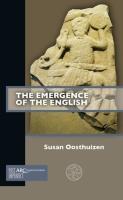
This book offers a reinterpretation of English history between AD 400 and 850, with a brief discussion of the subsequent ‘pre-Conquest’ period (850-1066). The author maintains that, contrary to the traditional view, Roman culture did not vanish during the fifth and sixth centuries; nor was Britain overrun by Germanic settlers. Romanitas survived here, as it did on the Continent. She classifies the period 400 to 600 as ‘late antique’ (not ‘early Anglo-Saxon’) and 600 to 850 as ‘early medieval’ (not ‘middle Anglo-Saxon’). This terminology aligns the history of Britain with that of mainland Europe, rather than treating it as an aberration.
Chapter 2 marshals the evidence in support of this view. St Patrick, writing in the mid-fifth century, speaks of Britain as a civilised country in contrast to Ireland, which was inhabited by barbarians and pagans. His family had a villa estate. His father was a deacon and a decurio, meaning a member of the Roman city council. Gildas, who wrote De Excidio Britanniae (‘On the Ruin of Britain’) in around 500, was seeking to demonstrate that God was punishing the Britons for rebelling against Roman rule. His account of the fifth century should be treated as polemic, rather than history. Bede’s famous history of the English church, completed in 731, draws heavily on Gildas. Bede, too, was writing with an agenda: namely to establish the supremacy of the church of Rome.
Thus, our three principal documentary sources, when properly analysed, do not support the conventional view that Roman culture died out soon after 409, when Britain dropped out of the Empire. Early Continental sources, such as Prosper’s account of a visit here by the bishop of Auxerre in 429, suggest that Britain was a stable and prosperous country. Archaeological evidence leads to a similar conclusion. Roman silver and bronze coins continued to circulate in the fifth and sixth centuries. Recent research shows that even wheel-thrown pottery survived in places, such as Nene Valley. Some Roman towns and villas remained as thriving settlements, even though many of the buildings fell into ruin. Genetic and isotopic research does not establish that immigration into Britain substantially increased during the fifth and sixth centuries. How the English language emerged during that period is more problematic. But—so the argument runs—we do not need to postulate substantive invasions from north west Europe to explain this linguistic development.
Chapter 3 contains a long discussion of ethnicity, which is socially rather than biologically constructed. The author concludes that this was not a fundamental value around which early medieval society was structured. So, we cannot infer that English ethnicity was the product of intermingling of the indigenous population with Germanic immigrants. The fourth and final chapter is entitled ‘Another perspective’. Drawing on the writings of the French historian Fernand Braudel, the author maintains that we should look at the post-Roman period in the context of a much longer chronological range—the longue durée. Romano-Britons evolved into English people gradually over a long period, not in response to a sudden mass immigration from north-west Europe. The Roman church survived at least in eastern England throughout the period from 409 until 595 when St Augustine arrived. Furthermore, as the author points out, subsistence farming dominated the lives of most people from the Iron Age to the medieval period. The rural economy and many of the field boundaries remained much the same through the Roman and post-Roman era. There was little disruption of property rights. The boundaries of commons and the nature of public rights over commons survived across the centuries.
This is a fascinating little book, which challenges all our received assumptions. If the author is correct, then classicists can take comfort in the thought that the Roman heritage is more deeply embedded in our culture than previously supposed. This reviewer is not entirely persuaded by the argument but recognises that it is formidable. This is a book for both general readers and specialists. Anyone with an interest in the late Roman period will enjoy reading it.
Rupert Jackson
